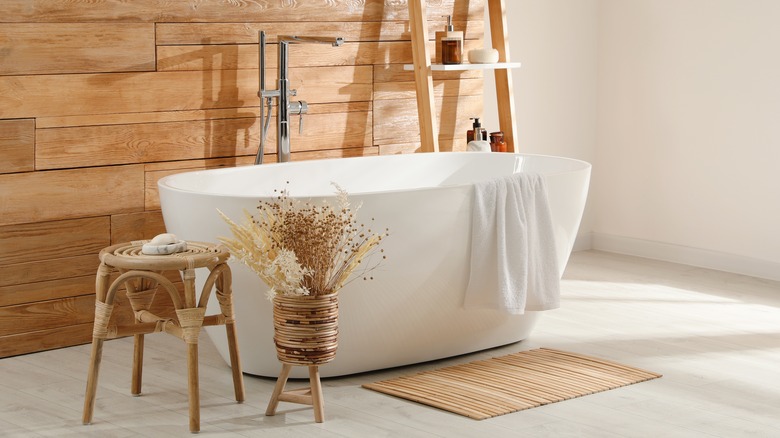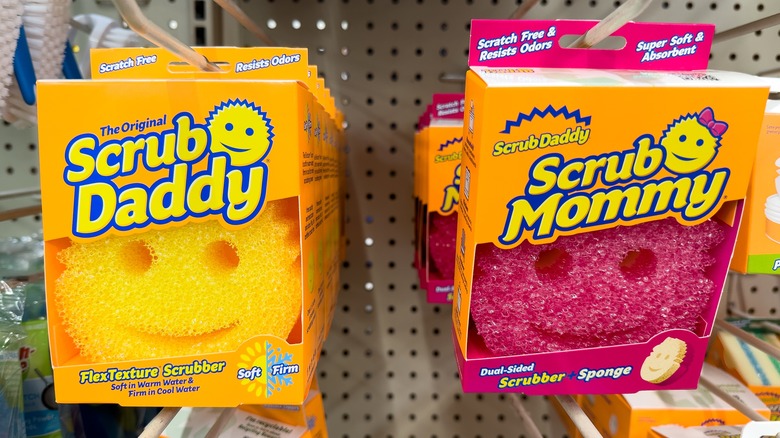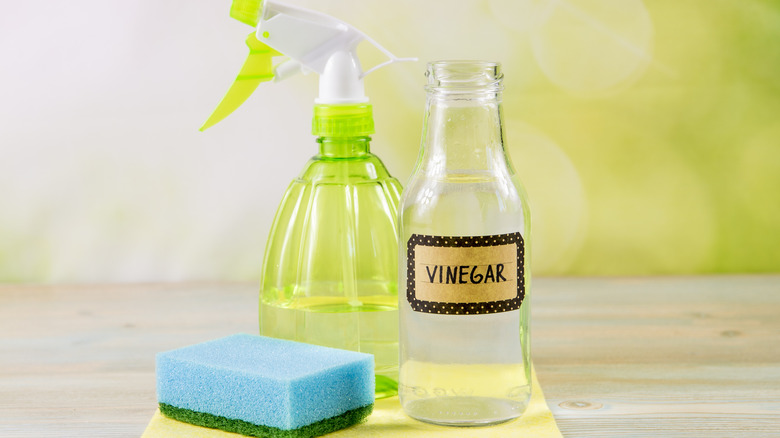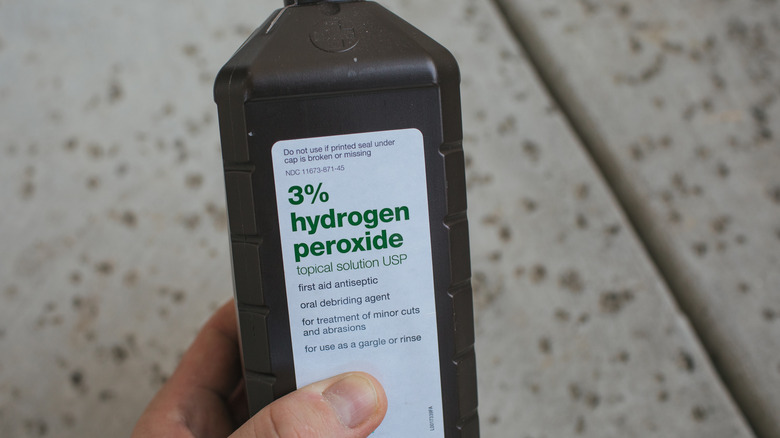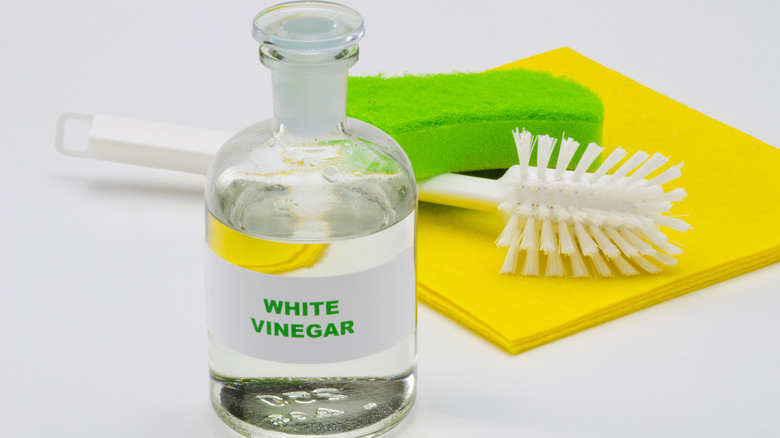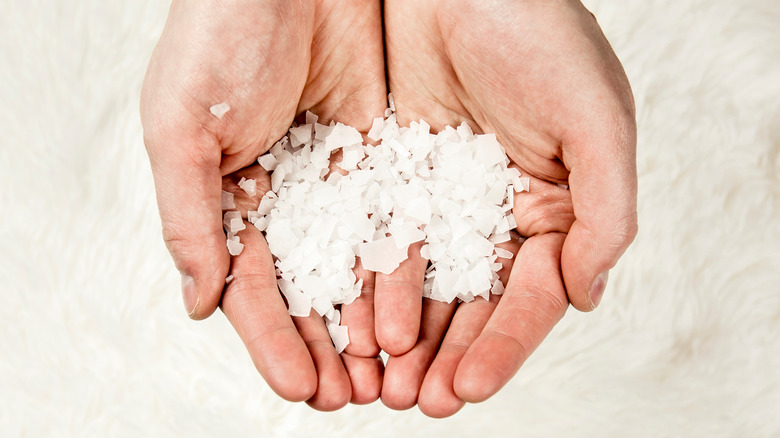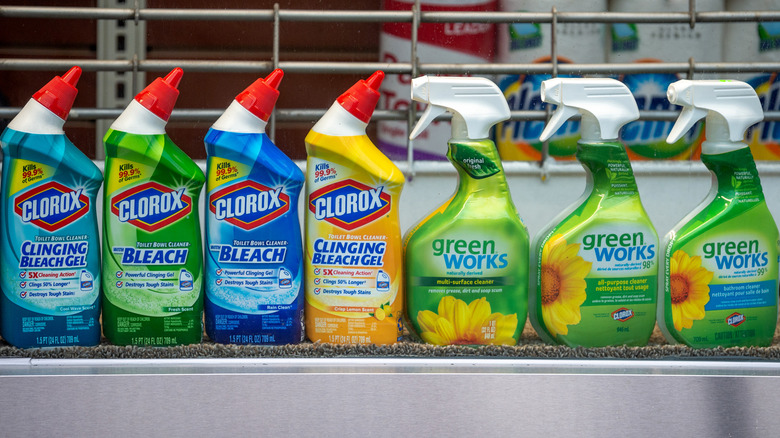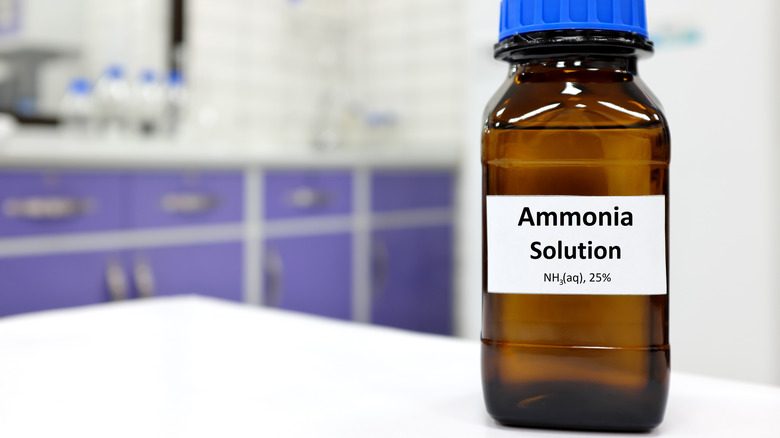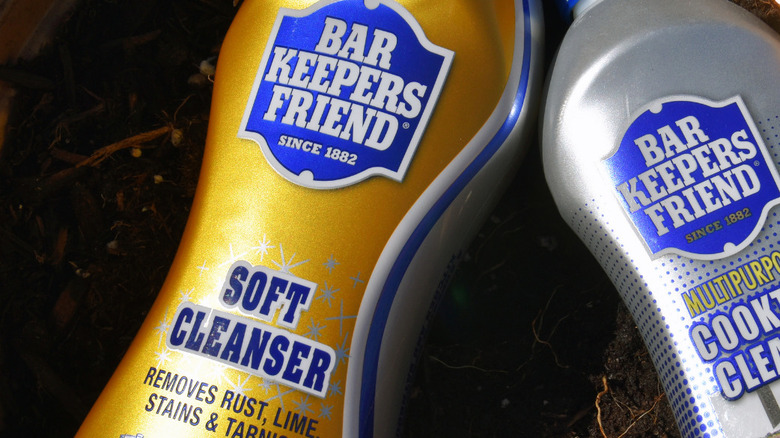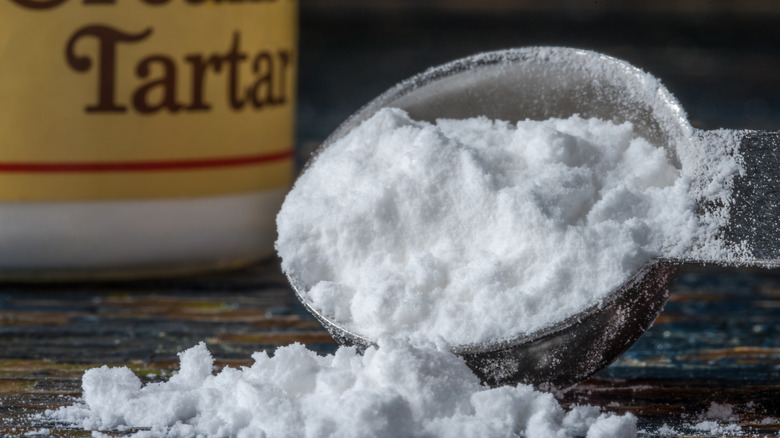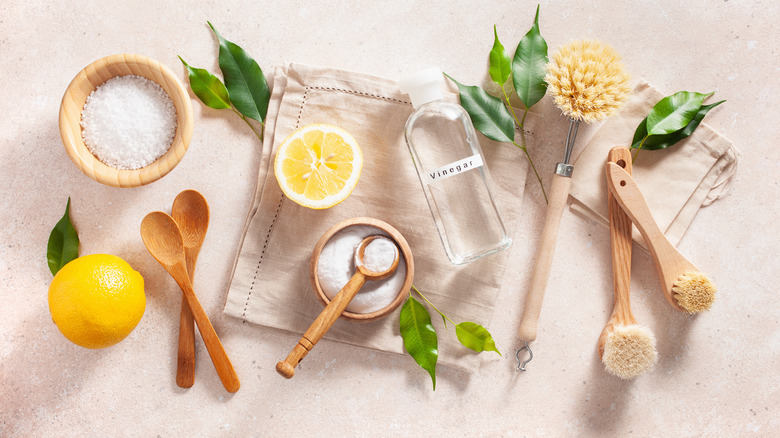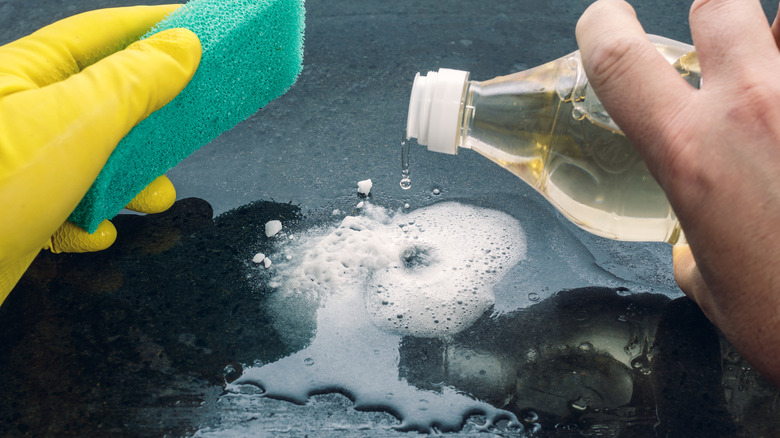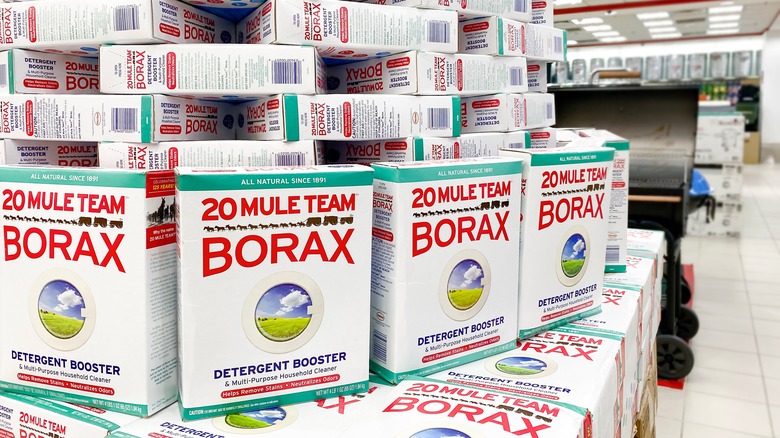Cleaning A Stained Bathtub Does Not Have To Be An Impossible Chore
Having a clean, stain-free bathtub is key to our overall health and peace of mind. We need to get rid of harmful substances like mold and mildew, plus unsightly things like hard water marks, rust, and scuff marks. You might be looking at the stains in your tub every day, just trying to find the will to embark on the impossible journey that will be finally getting rid of them.
But removing stains in your bathtub doesn't have to be a difficult chore. Whether you dyed your hair in the shower or it's just really old, you don't have to use a special cleaner to get results. You also don't have to spend hours on your hands and knees scrubbing, either. Often you can use things you already have around the house to get a clean, stain-free bathtub in no time, making the chore easy. We've compiled a list of what to use, depending on what type of stain you want to remove.
Invest in some good cleaning buddies for all stains
No amount of elbow grease will erase the stains on your tub if you don't have the correct tools. For most stains, you will need a scrubbing tool with a little bit of texture so you can have more friction when wiping things away. Things like rags, towels, and washcloths typically won't work well because they are too smooth. Instead, invest in generic things like a brush with firm bristles and a sponge with different textures on either side.
Name-brand items that are also helpful to have on hand are things like the Scrub Daddy and Magic Eraser. Both products have gone through years of research and development to be highly effective at making stain removal easy. The Scrub Daddy products have a coarse texture that can grip and lift stains, ensuring you don't have to press as hard to get rid of them. It's a similar story for the Magic Eraser, as Mr. Clean claims the tool can cut through even the toughest of stains with ease. No matter what tools you choose, the market is flooded with similar products to make your life easier.
For a mildew-free tub, use dish soap and white vinegar
Mildew is a type of fungus that thrives in moist environments. It often grows in parts of the home that are damp or humid, like the bathtub. It tends to stink after a while and also leaves behind gross brown stains. Getting rid of the mildew that builds up along the sides of your tub might seem a bit impossible, but it doesn't have to be. You don't even need to buy a new cleaning solution. It's likely that you already have the perfect supplies at home.
Check your kitchen for some dish soap and white vinegar. The first is a great cleaner because it can break down grease and grime, while the latter is a natural disinfectant that can kill bacteria and other germs that can harm you. Combining the two gives you a powerful cleaning solution that can make mildew disappear without much effort. To get started, mix equal parts dish soap and white vinegar in a clean spray bottle. Next, spritz the solution onto the stained parts of your tub and let it sit for about five minutes. This way, the solution will have enough time to work its magic. Finally, use a scrub brush or sponge to wipe any remaining mildew stains. You shouldn't have to use too much elbow grease for the stains to lift.
Use hydrogen peroxide and baking soda for dark stains
This technique is great for getting rid of darker stains like scuff marks or hair dye, as well as killing mold that leaves dark marks. Baking soda is a natural cleaner that's mildly abrasive because of its grainy texture. Since it's the right combination of rough and gentle, you can use it to scrub away at your bathtub without damaging the finish. Hydrogen peroxide is a type of bleach that can help lift and lighten stains. When you combine them, they form a paste-like substance that sticks to the surface to clean deeply. While sticking, the chemical reaction of baking soda and peroxide creates oxygen bubbles, which help lift dirt and stains from the bathtub's surface.
To use this solution, start by mixing equal parts baking soda and hydrogen peroxide in a bowl to create the paste. It's safe to use your hands to apply the paste to the stained areas of your bathtub, but for more accuracy, you should use a brush. Let the mixture sit for up to 20 minutes, even if the bubbles stop fizzing before then. Use your cleaning tool of choice to scrub away the stains. When you scrub, you might notice the stain hasn't lifted all the way. If this is the case, do not be discouraged. Just repeat the process as needed.
White vinegar and water is a natural bleach for hard water stains
Hard water stains are a type of mineral buildup that often happens in bathtubs. Hard water contains high levels of dissolved minerals, like calcium and magnesium. These minerals are not harmful to humans, whether you drink them or have them on your skin. However, when the hard water in your bathtub dries, it leaves behind small mineral deposits. They look a bit like white chalk. Like most stains, hard water deposits are easiest to eliminate when you haven't let them sit too long.
If you don't want to use bleach to remove them, you can use a natural alternative of white vinegar and water. Vinegar is an acidic substance, while hard water is more alkaline. When the two mix, they react, and the hard water deposits begin to break down. Always use white vinegar when cleaning. Vinegar with color can work the same, but its shade can cause new stains in the process. Mix vinegar and water in a 1:1 ratio in a spray bottle, shake it well, then apply to the stained surfaces. Let it sit for about 20 minutes to give the reactions time to complete, then scrub it off. This solution also works well if you spilled hair dye, used a bath bomb that stained your tub, or even scuffed the tub with the stopper.
Mix salt and white vinegar for a DIY stain-removing paste
Salt and vinegar paste works well for removing tough stains from laundry and can also work in the tub. It's so effective because the sharp flakes of salt are naturally abrasive. You can use their mass to get more friction when scrubbing. Add white vinegar for a kick of acidic power, and the stain should melt away.
When using this paste, be mindful of the amount of elbow grease you use. If you use table salt, you can be more vigorous as the smaller granules will not scratch the tub's porcelain. However, be more gentle if you use salt with larger granules, like rock salt or Himalayan salt. The paste will have more texture, so you won't have to push as hard to get the same results. This paste works best on hard water and stubborn mildew stains that you can't seem to get out of the grout.
Keep things classic and use bleach for tough stains
Bleach is one of the most powerful disinfectants and stain removers out there. It works so well because it is harsh and entirely unforgiving. You can use it to remove nearly any type of stain, including mold, mildew, soap scum, hard water, and hair dye. When creating your bleach solution, you typically mix it with water before applying instead of pouring bleach on the stain. Read the back of the bottle carefully, but you will typically use significantly less bleach than you might expect. Once mixed, you can use a spray bottle to apply the bleach mixture to the stained parts of your bathtub. As with most other solutions, you need to let the bleach sit on the stain for a few minutes, so it has time to react.
Next, scrub the solution with a "bleach-only" sponge or brush. Keeping a separate cleaning tool for bleach ensures you don't accidentally discolor something else in your home if you don't get all the bleach off the brush. Using bleach comes with a few cautions for your safety, too. When scrubbing, always wear rubber gloves, as it can hurt your skin if it touches you. In addition, be sure the room is well-ventilated so you don't breathe in the fumes.
Rid your tub of bodily fluid stains and use ammonia
Ammonia is great for removing any staining in the bathtub from our bodies, like blood, urine, or even vomit. If you have a pest problem in your home and have noticed animal waste in the tub that has stained, you should also reach for ammonia. The liquid is a secret weapon for removing stains like this because it's a base. This means that it has a high pH level. So, when it comes into contact with organic compounds from our bodies, which are usually acidic, it can bind to them easily. It then destroys the proteins in these fluids, dissolving them so you can wipe the stain away.
When using ammonia, read the back of the bottle you purchase for exact mixing and usage instructions. When you are trying to get out tough stains, it can be tempting to play chemist to get the best results, but remember that you should never combine ammonia with any other cleaner under any circumstances. The fumes created when you mix ammonia with bleach, for example, are mustard gas. This was a weapon of mass destruction used in World War I and is deadly.
Bar Keeper's Friend works great on rust, dyes, and oxidation
You can get rid of hair dye, rust, and hard water stains by using Bar Keeper's Friend. Its active ingredient is oxalic acid, a natural compound found in food. Its creator first discovered it while cooking rhubarb. This acid works by breaking down the chemical bonds that hold rust, spilled hair dyes, and other types of stains on the bathtub's surface. When oxalic acid comes into contact with these stains, it reacts with them and helps to dissolve them, making it much easier to scrub them away without too much effort.
In addition to the reaction of the acid, Bar Keeper's Friend also has small scratchy bits inside it. Just like baking soda, these particles are gentle enough that they won't scratch the tub's finishing, but will still scratch away the hard water stains and rust. It's easy enough to use and doesn't require too much elbow grease. You'll just need to wet the areas of the tub you plan to scrub before sprinkling the powder on the spot. This little bit of moisture helps the solution stay in place, even if it's on the sides of the tub.
Create a bleach substitute at home with cream of tartar and white vinegar
If you are looking at a tough stain and prefer not to use bleach, you can create a natural alternative that works nearly the same way. Mixing equal parts cream of tartar and vinegar creates a substance that can lift stains and whiten surfaces. Unlike bleach, this mixture has few antibacterial properties, so you must use another cleaning solution to disinfect the area once the stain is gone.
It works well because vinegar is an acid that can bond with the compounds in most stains, causing them to dissolve. When combined with cream of tartar, which is also acidic, the power is doubled. Plus, cream of tartar has a nice, powdery texture. When combined with vinegar, it creates a paste that can stick in more places (like on the tub's sides) than liquid or powder alone might. To make the mixture, get a small bowl and mix equal parts cream of tartar and vinegar. Mix the substance until it looks a bit like glue, then apply. Use gloves when applying the paste for the best results, as it can be challenging to remove from your hands.
Lemon and salt make a fresh-smelling scrub to eradicate dark mildew
If you want to eliminate mildew stains in your tub with something that smells great, consider a lemon and salt scrub. Lemons (and most citrus fruit) are highly acidic, which causes a chemical reaction with mildew stains. The acidity will eat away at the grime until it starts to dissolve. Adding salt gives the mixture just enough grip to pull any stubborn bits of gunk away. The gunk that lemon and salt work best on can be mold, mildew, or grime that leaves dark stains on the tub, especially on the caulking around the sides or the faucet.
Select a large lemon, cut it in half, and remove the seeds. Sprinkle a generous portion of salt over the top of the lemon, and scrub it against the stain. You can squeeze it so its juice runs out onto the stained area. You can also make a mixture of lemon juice and salt if you don't want to use the actual lemon. If you do this, use a small bowl and add the salt first. Add the lemon juice slowly and mix as you go. You want more of a paste-like texture instead of a liquid.
Use baking soda and white vinegar for green stains
The green stains in your tub are from a chemical reaction between your copper pipes and water. Plumbers like using copper because it is durable and can resist corrosion. However, copper still reacts with water to create copper oxide, which is a greenish-blue color. This staining is the same reason that the Statue of Liberty is now green, even though she was a polished bronze when she first arrived in the USA.
To remove these unsightly stains in your bathtub, you can make a paste of about 3 parts baking soda and 1 part water. Apply it to the bathtub surface wherever the green stains may be. Next, spray it with white vinegar. If you don't want to put the vinegar into a spray bottle, you can pour it directly from the source slowly. This process will work similarly to bleach. Let it sit for about 15 minutes so it has time to work, then vigorously scrub it with a brush or textured sponge. The stains should lift easily, but you can repeat the process if any hint of color remains. In addition to green stains, this mixture also destroys tough stains like hair dye, bath bomb residue, etc. '
Borax and dish soap make all stains easy to remove
Most of us use borax in the laundry room, but its cleaning powers can also be pretty helpful for getting rid of tough stains in the bathtub. It's a cleaning hack like no other that can get rid of mildew and mold that's built up and stained your tub black. It also works on dingey brown tubs that have been used for years and restores them to sparkling white.
Borax comes from Boron, which is a mineral. In its powdery-soap form, it's actually sodium borate, which reacts well with the compounds in lots of stains, causing them to dissolve. To get rid of rust stains and mildew, mix about ¼ cup of borax and ¼ cup of dish soap in a bowl. While wearing gloves for protection, rub the mixture into the stained areas of the tub. As with most solutions, let it sit for a few minutes before scrubbing it off with a stiff-bristled brush.
